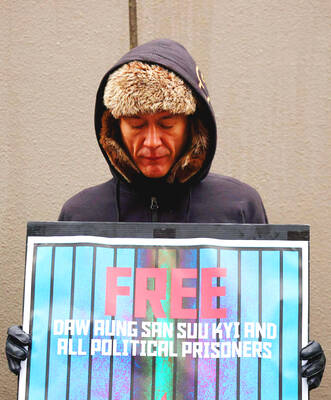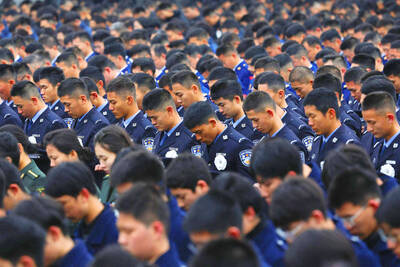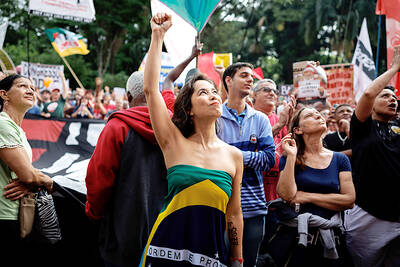The chorus of smiling Muslims and Han Chinese wore matching yellow polo shirts and appeared on television singing: “We are all part of the same family.”
The TV spot on Wednesday was the latest effort in a relentless propaganda campaign by the Chinese government to end the worst ethnic rioting in the far western Xinjiang region in decades.
However, the message was falling flat on the streets of the dusty jade-trading oasis city of Hotan, where many Muslims were still seething with resentment over the Han, the dominant ethnic group in China. The residents spoke about the long-standing tensions in hushed voices in the Silk Road town’s bustling bazaar, where donkeys pulled carts piled high with melons and women in colorful head scarves sold wheels of flat bread that looked like pizza crust.
One Muslim shopkeeper picked up a hatchet, raised it over his head and lowered it with one quick stroke, before saying: “That’s the best way to deal with the Han Chinese.”
The store owner, who only identified himself as Abdul, scoffed at the TV shows featuring members of his own Turkic minority ethnic group, the Uighurs, gushing about how harmonious and happy most of the people were in the sprawling oil-rich Xinjiang region, three times the size of Texas.
“I don’t believe these people,” the businessman said with a whisper, as he scouted the street for police. “They get paid to say these things. Ninety percent of the Uighurs don’t believe that stuff.”
The media campaign began after July 5 when ethnic rioting killed at least 192 people in Xinjiang’s capital, Urumqi. In the first days after the rioting, state-run media provided extensive reports about Uighurs savagely attacking Han Chinese, while playing down the subsequent Han-led violence. The government was quick to frame the Uighur attacks as an act of terrorism by a tiny minority of violent miscreants, led by the US-based Uighur dissident Rebiya Kadeer.
Kadeer has repeatedly denied the allegations and has condemned the violence.
As thousands of security forces restored order in Urumqi, the government’s propaganda campaign kicked in with TV shows, loudspeaker trucks and red banners. Many slogans warned against the “three evil forces” of terrorism, separatism and extremism. The campaign targeted all of Xinjiang, even Hotan on the edge of the Taklamakan desert — a two-hour flight south of Urumqi.
Hotan is predominantly Uighur. The city is famous for its carpets and a statue of late Communist leader Mao Zedong (毛澤東) shaking hands with a Uighur worker.
On Wednesday, the propaganda continued with local TV showing the Uighur and Han singers swaying together as they sang: “We are all part of the same family.”
There were also several personal profiles of Uighurs who acted heroically during the riots.
One elderly Uighur couple reportedly gave refuge to a Han teenager, allowing him to spend the night in their apartment until his father could pick him up in the morning.
Another Uighur man was an ambulance driver who continued to rescue the wounded, even though he was injured and the windows of his vehicle were smashed.
“I’m a Communist Party member,” the man said. “I should be doing more than the average citizen.”

The Burmese junta has said that detained former leader Aung San Suu Kyi is “in good health,” a day after her son said he has received little information about the 80-year-old’s condition and fears she could die without him knowing. In an interview in Tokyo earlier this week, Kim Aris said he had not heard from his mother in years and believes she is being held incommunicado in the capital, Naypyidaw. Aung San Suu Kyi, a Nobel Peace Prize laureate, was detained after a 2021 military coup that ousted her elected civilian government and sparked a civil war. She is serving a

China yesterday held a low-key memorial ceremony for the 1937 Nanjing Massacre, with Chinese President Xi Jinping (習近平) not attending, despite a diplomatic crisis between Beijing and Tokyo over Taiwan. Beijing has raged at Tokyo since Japanese Prime Minister Sanae Takaichi last month said that a hypothetical Chinese attack on Taiwan could trigger a military response from Japan. China and Japan have long sparred over their painful history. China consistently reminds its people of the 1937 Nanjing Massacre, in which it says Japanese troops killed 300,000 people in what was then its capital. A post-World War II Allied tribunal put the death toll

‘NO AMNESTY’: Tens of thousands of people joined the rally against a bill that would slash the former president’s prison term; President Lula has said he would veto the bill Tens of thousands of Brazilians on Sunday demonstrated against a bill that advanced in Congress this week that would reduce the time former president Jair Bolsonaro spends behind bars following his sentence of more than 27 years for attempting a coup. Protests took place in the capital, Brasilia, and in other major cities across the nation, including Sao Paulo, Florianopolis, Salvador and Recife. On Copacabana’s boardwalk in Rio de Janeiro, crowds composed of left-wing voters chanted “No amnesty” and “Out with Hugo Motta,” a reference to the speaker of the lower house, which approved the bill on Wednesday last week. It is

FALLEN: The nine soldiers who were killed while carrying out combat and engineering tasks in Russia were given the title of Hero of the Democratic People’s Republic of Korea North Korean leader Kim Jong-un attended a welcoming ceremony for an army engineering unit that had returned home after carrying out duties in Russia, North Korean state media KCNA reported on Saturday. In a speech carried by KCNA, Kim praised officers and soldiers of the 528th Regiment of Engineers of the Korean People’s Army (KPA) for “heroic” conduct and “mass heroism” in fulfilling orders issued by the ruling Workers’ Party of Korea during a 120-day overseas deployment. Video footage released by North Korea showed uniformed soldiers disembarking from an aircraft, Kim hugging a soldier seated in a wheelchair, and soldiers and officials